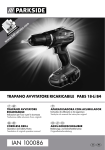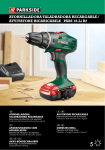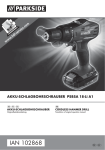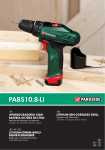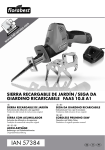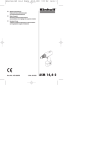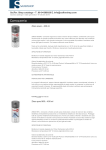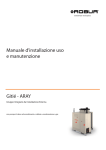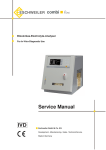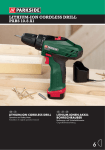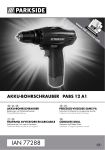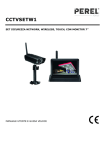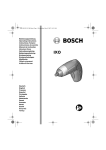Download IAN 90877 - Lidl Service Website
Transcript
T RAPANO AVVITATORE RICARICABILE PABS 18-Li B3 TRAPANO AVVITATORE ICARICABILE R I ndicazioni per l’uso e per la sicurezza T raduzione delle istruzioni d’uso originali AKKU-BOHRSCHRAUBER B edienungs- und Sicherheitshinweise Originalbetriebsanleitung IAN 90877 CORDLESS DRILL Operation and Safety Notes T ranslation of original operation manual P rima di leggere aprire la pagina con le immagini e prendere confidenza con le diverse funzioni dell’apparecchio. B efore reading, unfold the page containing the illustrations and familiarise yourself with all functions of the device. K lappen Sie vor dem Lesen die Seite mit den Abbildungen aus und machen Sie sich anschließend mit allen F unktionen des Gerätes vertraut. IT / MT Indicazioni per l’uso e per la sicurezza Pagina 5 GB / MTOperation and Safety Notes Page 15 DE / AT / CH Bedienungs- und SicherheitshinweiseSeite 25 11 12 1 2 10 3 9 8 4 7 6 A 5 B C 6 7 15 14 13 Indice Introduzione Uso conforme................................................................................................................................... Pagina6 Dotazione......................................................................................................................................... Pagina6 Ambito di fornitura........................................................................................................................... Pagina6 Dati tecnici........................................................................................................................................ Pagina6 Istruzioni di sicurezza generali per utensili elettrici 1. Sicurezza dell’area di lavoro..................................................................................................... Pagina7 2. Sicurezza elettrica....................................................................................................................... Pagina7 3. Sicurezza delle persone............................................................................................................. Pagina8 4. Utilizzo attento di dispositivi elettrici.......................................................................................... Pagina8 5. Utilizzo e trattamento dell’utensile ad accumulatore................................................................ Pagina9 6. Assistenza.................................................................................................................................... Pagina9 Indicazioni di sicurezza per trapani avvitatori ad accumulatore................................................. Pagina9 Avvertenze di sicurezza per caricabatteria................................................................................... Pagina10 Istruzioni aggiuntive......................................................................................................................... Pagina10 Accessori originali / apparecchi aggiuntivi.................................................................................... Pagina10 Messa in funzione Carica dell’accumulatore................................................................................................................ Pagina10 Inserimento / rimozione dell’accumulatore nell’apparecchio........................................................ Pagina11 Inserimento dell’accumulatore:....................................................................................................... Pagina11 Verifica dello stato dell’accumulatore............................................................................................ Pagina11 Sostituzione degli utensili................................................................................................................. Pagina11 Preselezione del momento torcente................................................................................................ Pagina11 Funzionamento a 2 marce.............................................................................................................. Pagina11 Uso Accensione / spegnimento............................................................................................................... Pagina12 Impostazione giri............................................................................................................................. Pagina12 Commutazione della direzione di rotazione.................................................................................. Pagina12 Consigli e suggerimenti................................................................................................................... Pagina12 Manutenzione e pulizia................................................................................................... Pagina13 Garanzia....................................................................................................................................... Pagina13 Smaltimento............................................................................................................................... Pagina13 Dichiarazione di conformità / Produttore......................................................... Pagina14 IT/MT 5 Introduzione Trapano avvitatore ricaricabile PABS 18-Li B3 Q Introduzione Ci congratuliamo con voi per l‘acquisto del vostro nuovo prodotto. Avete optato per un prodotto di alta qualità. Le istruzioni d‘uso sono parte integrante di questo prodotto. Esse contengono importanti avvertenze sulla sicurezza, l‘impiego e lo smaltimento. Prima dell‘utilizzo del prodotto, prendere conoscenza di tutte le istruzioni d‘uso e delle avvertenze di sicurezza. Utilizzare il prodotto solo come descritto e per i campi di applicazione indicati. Consegnare tutte le documentazioni su questo prodotto quando viene ceduto a terzi. Q Uso conforme Questo apparecchio è destinato alla foratura e avvitamento nel legno, plastica e metallo. Utilizzare l’apparecchio solo come descritto e per i campi di impiego indicati. Qualunque altro impiego o modifica dell’apparecchio è da considerarsi non conforme alla destinazione e comporta gravi rischi di infortunio. Il produttore non si assume alcuna responsabilità per i danni derivanti da un utilizzo non conforme. Non destinato all’uso commerciale. Q Dotazione 1 Selettore di marcia 2 Commutatore direzione di rotazione / blocco 3 Interruttore ON / OFF / Regolazione numero 4 5 6 7 di giri Supporto bit Supporto cintura Accumulatore Tasto di sblocco dell’accumulatore 8 LED di visualizzazione dell’accumulatore 9 Tasto di stato dell’accumulatore 10 Lampada da lavoro a LED 11 Mandrino portapunta 6 IT/MT 12 Preselezione del momento torcente 13 Caricabatterie rapido 14 LED rosso per il controllo di carica 15 LED verde per il controllo di carica Q Ambito di fornitura 1 trapano avvitatore ricaricabile completo di accumulatore 1 bit PH2 50 mm 1 caricabatterie rapido 1 valigetta 1 libretto d’istruzioni d’uso Q Dati tecnici PABS 18-Li B3 Trapano avvitatore ricaricabile: Tensione nominale: 18 V Velocità a vuoto: 1a velocità: max. 400 min-1 Velocità a vuoto: 2a velocità: max. 1400 min-1 Capacità di chiusura del mandrino portapunta: max. 13 mm Diametro max. di foraturaAcciaio: 13 mm, legno: 30 mm PABS 18-Li B3-1 Accumulatore: Tipo:LITIO-IONE Tensione nominale: 18 V Capacità: 1,3 Ah Contenuto energetico: 23,4 Wh PABS 18-Li B3-2 Caricabatterie rapido: INGRESSO / Input: Tensione nominale: 230–240 V∼, 50 Hz Assorbimento di potenza: 45 W USCITA / Output: Tensione nominale: Corrente di carica: Durata della carica: Classe di protezione: 18 V 1,5 A ca. 60 min. II / Introduzione / Istruzioni di sicurezza generali per utensili elettrici Informazioni per il rumore e le vibrazioni I valori di misurazione sono stati accertati in applicazione delle norme EN 60745. Il livello di pressione acustica stimato A ammonta tipicamente a: Livello di pressione acustica: 69 dB(A) Livello di intensità sonora: 80 dB(A) Scostamento di K: 3 dB I valori complessivi di vibrazione (somma vettoriale relativa a tre direzioni) sono stati rilevati in conformità alle disposizioni della norma EN 60745: Viti: Valore di emissione di vibrazione ah = 0,824 m / s2, Scostamento K = 1,5 m / s2, Trapano:Valore di emissione di vibrazione ah,D = 2,47 m / s2, Scostamento K = 1,5 m / s2. Il valore relativo al livello di vibrazioni indicato nelle presenti istruzioni d’uso è stato misurato in conformità alla procedura di misurazione esplicata nella norma EN 60745 e può essere utilizzato per il confronto tra apparecchi. Il valore relativo all’emissione delle vibrazioni può essere utilizzato anche per stabilire una valutazione iniziale della sospensione. Il livello di vibrazione potrà variare a seconda dell’impiego dell’utensile elettrico e in alcuni casi può essere superiore al valore indicato nelle presenti istruzioni. Il carico di vibrazione potrebbe essere stimato in difetto, perché l’utensile elettrico viene utilizzato sempre in modalità simili. Nota: Per una corretta valutazione dell’affaticamento da vibrazioni durante un determinato periodo di lavorazione devono essere considerati anche i tempi in cui l’apparecchio è disinserito o è funzionante, senza però essere utilizzato. Ciò può ridurre in misura notevole l’affaticamento da vibrazioni lungo il periodo di lavorazione complessivo. Istruzioni di sicurezza generali per utensili elettrici Leggere tutte le indicazioni e gli avvisi di sicurezza! Eventuali mancanze nell’osservanza delle indicazioni e degli avvisi di sicurezza possono pro vocare una scossa elettrica, un incendio e / o gravi lesioni. Conservare tutte le indicazioni e gli avvisi di sicurezza per eventuali necessita’ future! La parola “attrezzo elettrico“ utilizzata nelle istruzioni d’uso si riferisce agli attrezzi elettrici funzionanti all’interno di una rete (con cavo di rete) e agli at trezzi elettrici che funzionano mediante batterie (senza cavo di rete). 1. Sicurezza dell’area di lavoro a) Mantenere l’area di lavoro pulita e ben illuminata. Il disordine ed aree di lavoro poco illuminate possono determinare incidenti. b) Non lavorare con l’apparecchio in un’atmosfera dove si trovino liquidi infiammabili, esplosiva, gas e polveri. Gli utensili elettrici generano scintille che pos sono infiammare la polvere o i gas. c) Durante l’utilizzo del dispositivo elettrico tenere lontani bambini e persone estranee. In caso di distrazione potreste perdere il controllo dell’apparecchio. 2. Sicurezza elettrica a) La spina di connessione dell‘utensile elettrico (o dell‘alimentatore) deve essere adatta alla presa elettrica nella quale viene inserita. La spina non deve essere modificata in alcun modo. Non collegare adattatori a utensili elettrici con messa a terra. Spine non modificate e prese adatte riducono il rischio di scossa elettrica. b) Evitare il contatto del corpo con superfici messe a terra, quali ad esempio quelle IT/MT 7 Istruzioni di sicurezza generali per utensili elettrici di tubi, caloriferi, cucine economiche e frigoriferi. Sussiste un elevato rischio di scossa elettrica, qualora il Vostro corpo fosse messo a terra. c) Mantenere l’apparecchio lontano da pioggia o umidità. La penetrazione di acqua in un apparecchio elettrico accresce il rischio di scossa elettrica. d) Non utilizzare il cavo in modo non conforme, cioè per tirare l’apparecchio, per appenderlo o per estrarre la spina dalla presa elettrica. Tenere il cavo lontano da calore, olio, spigoli acuti o di parti in movimento dell’apparecchio. Cavi danneggiati o attorcigliati accrescono il rischio di scossa elettrica. e) In caso di lavori all’aperto utilizzare solamente prolunghe ammesse anche per un loro utilizzo all‘aperto. L’utilizzo di una tale prolunga riduce il rischio di scossa elettrica. f) Qualora non si possa evitare l‘esercizio dell’elettroutensile in un ambiente umido, fare uso di un interruttore differenziale, circostanza che riduce il rischio di una scossa elettrica. 3. Sicurezza delle persone a) Fare sempre estrema attenzione a ciò che si fa e accostarsi al lavoro con il dispositivo elettrico sempre in modo cosciente. Non utilizzare l’apparecchio quando si è stanchi o sotto l’influsso di droghe, alcol o medicinali. Un solo attimo di disattenzione nell’utilizzo dell’appa recchio può provocare serie lesioni. b) Indossare sempre l’equipaggiamento di protezione personale e gli occhiali protettivi. Indossando l’equipaggiamento di protezione personale, quale una mascherina antipolvere, scarpe di sicurezza antisdrucciole voli, un casco di protezione o una protezione auricolare, a seconda del tipo e dell’utilizzo dell’apparecchiatura elettrica, riduce il rischio di lesioni. 8 IT/MT c) Evitare qualsiasi avvio involontario dell’utensile. Evitare qualsiasi avvio involontario dell’utensile. Assicurarsi che l’utensile sia spento prima di collegarlo alla rete di alimentazione elettrica, di sollevarlo o di trasportarlo. Se durante il trasporto dell’apparecchio il dito dell’utilizzatore si trova sull’interruttore ON / OFF oppure l’apparecchio è inserito, possono determinarsi incidenti. d) Prima di avviare l’apparecchio, rimuovere il dispositivo di regolazione o la chiave per dadi. Un utensile o una chiave che si trovi in una parte di apparecchio in ro tazione può provocare lesioni. e) Mantenere una postura del corpo normale. Assicurarsi di avere un sostegno sicuro e mantenere sempre l’equilibrio. In questo modo è possibile controllare meglio l’apparecchio, in modo particolare in caso di situazioni impreviste. f) Indossare un abbigliamento appropriato. Non indossare un abbigliamento largo o bigiotteria. Mantenere capelli, abbigliamento e guanti lontano da parti in movimento. Abbigliamento sciolto, gioielli o capelli lunghi possono essere trascinati da parti in movimento. g)Quando vengono montati dispositivi di aspirazione e di cattura della polvere, assicurarsi che questi siano stati montati ed utilizzati correttamente. L’utilizzo di questi dispositivi riduce i pericoli provocati dalla polvere. 4. Utilizzo attento di dispositivi elettrici a) Non sovraccaricare l’apparecchio. Per un determinato lavoro utilizzare sempre il dispositivo elettrico a ciò appropriato. Con il dispositivo elettrico appro priato si lavora meglio e con maggiore sicurezza nello specifico ambito di utilizzo. b) Non utilizzare dispositivi elettrici il cui interruttore sia difettoso. Un dispositivo elettrico che non si può più accendere e spe Istruzioni di sicurezza generali per utensili elettrici gnere rappresenta un pericolo, e deve essere riparato. c) Estrarre la spina dalla presa elettrica di rete e / o rimuovere l’accumulatore prima di eseguire regolazioni all’appa recchio, sostituire accessori o riporre l’apparecchio. Queste misure di prevenzione impediscono l’avvio involontario dell’appa recchio elettrico. d) Mantenere dispositivi elettrici non utilizzati fuori dalla portata di bambini. Non fare utilizzare l’apparecchio da persone che non lo conoscano o del quale non abbiano letto le istruzioni d’uso. I dispositivi elettrici sono pericolosi se utilizzati da persone inesperte. e) Avere cura dell’apparecchio. Controllare se parti mobili dell’apparecchio funzionano perfettamente e non si bloccano, se parti di esso sono rotte o danneggiate, che la funzionalità dell’apparecchio non sia messa a rischio. Fare riparare le parti danneggiate prima di utilizzare di nuovo l’apparecchio. Molti incidenti sono provocati dal fatto che i dispositivi elettrici non vengono sottoposti ad una corretta manutenzione. f) Mantenere gli utensili di taglio affilati e puliti. Utensili di taglio curati con attenzione e fornitidi bordi taglienti si incastrano meno frequentemente e sono semplici da guidare durante il lavoro. g) Utilizzare dispositivi elettrici, accessori, i dispositivi da inserire ecc, in conformità alle presenti istruzioni e nel modo descritto per questo particolare tipologia di apparecchio. In questo senso, tenere presente le condizioni di lavoro e l’attività da eseguire. L’utilizzo di dispo sitivi elettrici per scopi diversi da quelli previsti può provocare situazioni di pericolo. 5.Utilizzo e trattamento dell’utensile ad accumulatore a) C ollegare gli accumulatori solo in caricatori suggeriti dal produttore. Un caricatore adatto ad un particolare tipo di accumulatore può provocare un incendio se utilizzato con altri accumulatori. b) Utilizzare nell’apparecchio elettrico solamente accumulatori previsti per tale tipologia di apparecchi. L’utilizzo di altri accumulatori può provocare lesioni e determinare un pericolo di incendio. c) Mantenere l’accumulatore non utilizzato lontano da graffette per ufficio, monete, chiavi, chiodi, viti o altri piccoli oggetti metallici, i quali potrebbero provocare un cavallottamento dei con tatti. Un cortocircuito tra i contatti dell’accu mulatore può avere come conseguenza bruciature o incendi. d) Del liquido può fuoriuscire dall’accumulatore in caso di suo errato utilizzo. Evitare qualsiasi contatto con tale liquido. In caso di contatto accidentale risciacquare con acqua. Se il liquido viene a contatto con gli occhi, chiedere l’intervento di un medico. Il liquido fuo riuscito dall’accumulatore può provocare irri tazioni alla pelle o bruciature. A TTENZIONE! PERICOLO DI ESPLOSIONE! Non ricaricare mai batterie non ricaricabili. 6.Assistenza a) Fare riparare l’apparecchio dal Centro di Assistenza o da un elettricista specializzato e solo con pezzi di ricambio originali. In questo modo viene garantita la sicurezza dell’apparecchio. Indicazioni di sicurezza per trapani avvitatori ad accumulatore Tenere l’apparecchio per le superfici di presa isolate quando si eseguono lavori in occasione dei quali la vite può incontrare linee elettriche o il cavo di alimentazione dell’ap parecchio medesimo. Il contatto della vite con una linea di conduzione di corrente può metIT/MT 9 Istruzioni di sicurezza generali per utensili elettrici / Messa in funzione tere sotto tensione anche parti metalliche dell’apparecchio e provocare una scossa elettrica. Avvertenze di sicurezza per caricabatteria S enza la sorveglianza o la guida di una persona responsabile, questo apparecchio non deve essere utilizzato da bambini né da persone non in possesso della conoscenza e dell’esperienza necessarie per maneggiarlo, o le cui capacità corporali, sensoriali o intellettuali fossero limitate. I bambini devono essere sorvegliati affinché non giochino con l’apparecchio. Istruzioni aggiuntive B loccare il pezzo da lavorare. Un pezzo bloccato con un dispositivo di bloccaggio o da una morsa a vite viene trattenuto con maggiore sicurezza che non nella mano dell’utilizzatore. POLVERI VELENOSE! Le polveri dannose / velenose generate durante la lavorazione rappresentano un pericolo per la salute dell’operatore e delle persone che si trovano nelle vicinanze. Indossare occhiali protettivi e una mascherina antipolvere! Non lavorare materiale contenente asbesto. L’asbesto è ritenuto un materiale cancerogeno. Mantenere ben fermo l’apparecchio elettrico. Stringendo o allentando viti si possono generare improvvise ed elevate coppie di reazione. Disinserire immediatamente l’utensile elettrico quando l’utensile utilizzato si blocca. L’utilizzatore deve essere pronto per elevate coppie di reazione che provocano un contraccolpo. L’utensile utilizzato si blocca quando l’utensile elettrico viene sovraccaricato o si ribalta nel pezzo da lavorare. In caso di interventi sull’apparecchio o di sua movimentazione o immagazzinaggio è necessario portare il selettore di senso di rotazione in posizione 10 IT/MT centrale (di fermo). In questo modo si evita qualsiasi avvio involontario dell‘apparecchio. Pericolo! Accertarsi di non intercettare linee di corrente, condutture di gas o acqua, mentre si lavora con un elettroutensile. Controllare eventualmente con un rilevatore di linee, prima di perforare o fendere una parete. Q Accessori originali / apparecchi aggiuntivi U tilizzare solo accessori e apparecchi aggiuntivi indicati nel manuale di istruzioni. L’uso di apparecchi diversi da quelli consigliati o da altri accessori indicati nel manuale di istruzioni può comportare il pericolo di lesioni. Messa Q Carica in funzione dell’accumulatore ATTENZIONE! Staccare sempre la spina dalla presa prima di prelevare o inserire l’accumulatore nell’apparecchio. N on caricare l’accumulatore se la temperatura ambiente è al di sotto di 10 °C o al di sopra di 40 °C. 1.Inserire l’accumulatore 6 nel caricatore veloce 13 (vedi fig. C). 2.Inserire la spina nella presa di rete. Il LED di controllo ricarica verde lampeggiante 15 mostra ora il processo di ricarica. 3.Non appena il LED di controllo ricarica verde 15 si accende, il processo di ricarica è concluso e l‘accumulatore 6 è pronto all‘uso. 4.Quando il LED di controllo ricarica rosso 14 si accende, allora il caricatore rapido 13 si trova in modalità di standby; l‘accumulatore 6 non è collegato. 5.Quando il LED di controllo ricarica 14 lampeggia, allora l‘accumulatore 6 si è surriscaldato; il processo di ricarica non è in corso. Messa in funzione N on caricare mai per la seconda volta l’accu-mulatore subito dopo un procedimento di carica rapida. Sussiste il pericolo di sovraccarico dell’accumulatore e conseguente riduzione della durata di vita dell’accumulatore e del caricabatteria. Spegnere il caricatore per almeno 15 minuti fra due procedimenti di carica consecutivi. Staccare la spina dalla presa di corrente. Q Inserimento / rimozione dell’accu mulatore nell’apparecchio Inserimento dell’accumulatore: Posizionare il commutatore del senso di rotazione 2 in posizione centrale (blocco). Inserire la batteria 6 nell‘impugnatura. Rimozione dell’accumulatore: Premere il tasto di sbloccaggio 7 e rimuovere l’accumulatore. Q Verifica dello stato dell’accumulatore P er verificare lo stato di caricamento dell’accumulatore premere il tasto Accu-LED 9 (vedi anche la figura principale). Lo stato nonché la potenza residua sono visualizzabili sulle tre spie a LED 8 della batteria nel seguente modo: VERDE / ROSSO / ARANCIONE = caricamento / potenza massimi ROSSO / ARANCIONE = caricamento / potenza medi ROSSO = caricamento debole - è necessario caricare l’accumulatore Q Sostituzione degli utensili Dopo aver inserito l’utensile desiderato e averlo fissato tramite rotazione del mandrino , si può continuare immediatamente con il lavoro. L’ arresto del mandrino si disattiva automaticamente con l’avvio del motore (azionamento dell’interruttore ON / OFF 3 ). Q Preselezione del momento torcente Tramite la preselezione del momento torcente 12 si può regolare la forza di torsione. S elezionare un livello basso per viti piccole, materiali morbidi. Selezionare un livello alto per viti grandi, materiali duri, o nell’estrazione di viti. Per i lavori di perforazione, selezionare il livello di perforazione, impostando la preselezione del momento torcente in posizione . Q Funzionamento a 2 marce ATTENZIONE! Operare l’interruttore di selezione della velocità 1 solo ad apparecchio disinserito. In caso contrario l’apparecchio potrebbe subire dei danni. Nella prima marcia (selettore di marcia 1 in posizione: 1) si ottiene un numero di giri di ca. 400 min-1 e un elevato momento torcente. Questa impostazione è idonea per tutti i lavori di avvitamento, ma anche per l’impiego di accessori (vedi esempio Fig. B). Nella seconda marcia (selettore di marcia 1 in posizione: 2) si ottiene un numero di giri di ca. 1400 min-1 per l’esecuzione di lavori di perforazione (vedi esempio Fig. A). Il vostro avvitatore a batteria è dotato di blocco automatico del mandrino . Con motore fermo, la trasmissione viene bloccata, per consentire di aprire il mandrino a serraggio rapido 11 tramite rotazione . IT/MT 11 Uso Uso Q Accensione / spegnimento Accensione: Per mettere in funzione l’apparecchio, premere l’ interruttore ON / OFF 3 e tenerlo premuto. La lampada a LED 10 si illumina qualora l’interruttore ON / OFF 3 venga premuto leggermente o fino in fondo, e permette in questo modo l’illuminazione dell’area di lavoro in caso di condizioni di luce sfavorevoli. Spegnimento: Per spegnere l’apparecchio, rilasciare l’interruttore ON / OFF 3 . Impostazione giri L’interruttore di ON / OFF 3 dispone di un sistema di regolazione variabile della velocità. Una leggera pressione sull’interruttore ON / OFF 3 determina un funzionamento a bassa velocità. Aumentando la pressione sull’interruttore la velocità si accresce. Nota: Il freno motore integrato fa in modo che si giunga a un celere arresto. Q Commutazione della direzione di rotazione P er commutare la direzione di rotazione, premere il commutatore di direzione di rotazione 2 a destra o a sinistra. Q Consigli e suggerimenti P rima della messa in funzione, controllare che l’accessorio per l’avvitamento o la perforazione sia stato inserito correttamente, cioè centrato nel mandrino. I bit per l’avvitamento sono contrassegnati con dimensioni e forma. In caso di dubbio, controllare prima che il bit entri nella testa della vite senza gioco. 12 IT/MT Momento torcente: Viti speciali più piccole e bit possono danneggiarsi se si regola un momento torcente e / o un numero di giri troppo elevato sull’apparecchio. Avvitatura rigida (nel metallo): Momenti torcenti particolarmente elevati si formano ad es. in caso di avvitamento di metalli con l’uso di inserti con chiave a bussola. Selezionare un numero di giri inferiore. Avvitatura morbida (ad esempio nel legno morbido): Avvitare anche qui con un numero di giri inferiore, per ad es. non danneggiare la superficie di legno al contatto con la testa della vite in metallo. Utilizzare un allargatore. Nella perforazione di materiali come legno, metallo e altro, tenere assolutamente presente quanto segue: in caso di diametro di perforazione ridotto, utilizzare un alto numero di giri, e in caso di diametro di perforazione più ampio un numero di giri inferiore. Per i materiali duri scegliere un numero di giri basso, per i materiali morbidi un numero di giri alto. Fissare o assicurare (se possibile) il pezzo da lavorare con un dispositivo apposito. Marcare il punto da perforare con un punzone o un chiodo e per perforare scegliere un numero di giri basso. Estrarre più volte la punta del trapano dal foro, per rimuovere i trucioli o la segatura e per farla aerare. Perforazione del metallo: Utilizzare punte in metallo (HSS). Per ottenere i risultati migliori, raffreddare la punta con olio. La punta in metallo può essere anche utilizzata per perforare la plastica. Perforazione della pietra: Utilizzare una punta per pietre in metallo duro. Perforazione del legno: Utilizzare una punta in legno con punta centrata, per perforazioni profonde utilizzare una “punta Uso / Manutenzione e pulizia / Garanzia / Smaltimento a elica”, per diametri di foratura maggiori una punta Forstner. Le viti piccole nel legno morbido possono essere inserite anche senza precedente foratura. Manutenzione e pulizia PERICOLO DI LESIONI! Prima di eseguire qualsiasi intervento sull’apparecchio estrarre la spina dalla presa. La batteria dell‘avvitatore non necessita di manutenzione. L’apparecchio deve essere sempre pulito, asciutto e privo di tracce di olio o di grasso. Utilizzare un panno asciutto per pulire la custodia. Se è necessario sostituire il cavo di raccordo, far eseguire il lavoro dal produttore o dal rappresentante del produttore per evitare eventuali danni. QGaranzia Questo apparecchio è garantito per tre anni a partire dalla data di acquisto. L’apparecchio è stato prodotto con cura e debitamente collaudato prima della consegna. Conservare lo scontrino come prova d’acquisto. In caso di interventi in garanzia, contattare telefonicamente il proprio centro di assistenza. Solo in questo modo è possibile garantire una spedizione gratuita della merce. La garanzia vale solo per i difetti di materiale o fabbricazione, non per i danni da trasporto, parti soggette a usura o danni a parti fragili come ad es. interruttori o accumulatori. Il prodotto è destinato esclusivamente all’uso domestico e non a quello commerciale. La garanzia decade in caso di impiego improprio o manomissione, uso della forza e interventi non eseguiti dalla nostra filiale di assistenza autorizzata. Questa garanzia non costituisce alcun limite ai diritti legali del consumatore. Il periodo di garanzia non viene prolungato in caso di un intervento in garanzia. Ciò vale anche per le componenti sostituite e riparate. I danni e difetti presenti già all’acquisto devono essere comunicati immediatamente dopo il disimballaggio, e non oltre due giorni dalla data di acquisto. Le riparazioni effettuate dopo la scadenza del periodo di garanzia sono a pagamento. IT Assistenza Italia Tel.: 02 36003201 e-mail: [email protected] IAN 90877 MT Assistenza Malta Tel.:80062230 e-mail:[email protected] IAN 90877 Q Smaltimento L’imballaggio consiste esclusivamente di materiali ecocompatibili. Smaltirli negli appositi contenitori di riciclaggio locali. N on gettare mai gli elettroutensili insieme ai normali rifiuti domestici! A norma della direttiva europea 2002 / 96 / EC sui rifiuti da apparecchiature elettriche ed elettroniche e relativa trasformazione in legge nazionale, gli elettrodomestici usati devono essere raccolti separatamente e destinati al riciclaggio nel rispetto dell’ambiente. Non gettare le batterie nella spazzatura domestica! Gli accumulatori difettosi o esausti devono essere riciclati in base alla direttiva 2006 / 66 / EC. Riconsegnare gli accumulatori e / o i caricabatteria presso gli appositi centri di raccolta. IT/MT 13 Smaltimento / Dichiarazione di conformità / Produttore Per lo smaltimento dell’apparecchio usato, informarsi presso l’amministrazione comunale o municipale. Q Dichiarazione Produttore di conformità / Noi, KompernaSS HANDELS GmbH, responsabile per la documentazione: sig. Semi Uguzlu, BurgstrASSE 21, 44867 Bochum, GermANY, dichiarano con la presente che questo prodotto è conforme con le seguenti norme, documenti normativi e direttive dell’Unione Europea: Direttiva macchine (2006 / 42 / EC) Direttiva CE Bassa tensione (2006 / 95 / EC) Compatibilità elettromagnetica (2004 / 108 / EC) RoHS Direttiva (2011 / 65 / EU) Norme utilizzate ed armonizzate EN 60745-1:2009+A11, EN 60745-2-1:2010 EN 60745-2-2:2010, EN 55014-1:2006+A1+A2 EN 55014-2:1997+A1+A2, EN 61000-3-2:2006+ A1+A2, EN 61000-3-3:2008 EN 60335-1:2002+A1+A11+A12+A2+A13+A14+ A15, EN 60335-2-29:2004, EN 62233:2008 Tipo / contrassegno apparecchio: Trapano avvitatore ricaricabile PABS 18-Li B3 Date of manufacture (DOM): 07–2013 Numero di serie: IAN 90877 Bochum, 31.07.2013 Semi Uguzlu - Direttore del Reparto Qualità Con riserva di modifiche tecniche volte al miglioramento del prodotto. 14 IT/MT Table of contents Introduction Intended purpose.................................................................................................................................Page16 Equipment Components.......................................................................................................................Page16 Scope of delivery.................................................................................................................................Page16 Technical Data.....................................................................................................................................Page16 General safety advice for electrical power tools 1. Workplace safety............................................................................................................................Page17 2. Electrical safety................................................................................................................................Page17 3. Personal safety.................................................................................................................................Page18 4. Careful handling and use of electrical power tools......................................................................Page18 5. Use and handling of the cordless electrical power tool...............................................................Page19 6. Service..............................................................................................................................................Page19 Safety advice relating to cordless drill drivers...................................................................................Page19 Safety notices for chargers..................................................................................................................Page19 Supplementary Instructions..................................................................................................................Page19 Original ancillaries / accessories........................................................................................................Page20 Start-up Charging the battery pack..................................................................................................................Page20 Insertion / removal of a battery pack into the appliance...................................................................Page20 Checking battery status.......................................................................................................................Page20 Changing tools.....................................................................................................................................Page20 Torque pre-selection.............................................................................................................................Page21 2 Gear Drive........................................................................................................................................Page21 Operation Switching On / Off...............................................................................................................................Page21 Setting the speed..................................................................................................................................Page21 Switching direction of rotation............................................................................................................Page21 Tips and Tricks......................................................................................................................................Page21 Maintenance and Cleaning...............................................................................................Page22 Warranty..........................................................................................................................................Page22 Disposal.............................................................................................................................................Page23 Conformity Declaration / Manufacturer.................................................................Page23 GB/MT 15 Introduction Cordless drill PABS 18-Li B3 Introduction We congratulate you on the purchase of your new device. You have chosen a high quality product. The instructions for use are part of the product. They contain important information concerning safety, use and disposal. Before using the product, please familiarise yourself with all of the safety information and instructions for use. Only use the unit as described and for the specified applications. If you pass the product on to anyone else, please ensure that you also pass on all the documentation with it. Intended purpose This appliance is designed for drilling and screwing into wood, plastic and metal. Use the appliance only as described and only for the purposes indicated. Any other uses, and modifications to the appliance, are deemed to be improper usage and may result in serious physical injury. The manufacturer accepts no responsibility for damage(s) resulting from improper usage. The appliance is not intended for commercial use. Equipment Components 1 Gear selector switch 2 Direction of rotation switch / lock 3 ON / OFF Switch / R.P.M. regulator 4 Bit holder 5 Belt clip 6 Rechargeable battery pack 7 Battery pack release button 8 Rechargeable battery display LED 9 Rechargeable battery charge state button 10 LED working light 11 Drill chuck 12 Torque pre-selector 13 Fast charger 14 Red charge-control LED 15 Green charge-control LED 16 GB/MT Scope of delivery 1 Cordless drill with rechargeable battery pack 1 Bit PH2 50 mm 1 Fast charger 1 Carry case 1 Directions for use Technical Data PABS 18-Li B3 Cordless drill: Nominal voltage: 18 V Idle-running speed: 1st gear: max. 400 min-1 Idle-running speed: 2nd gear: max. 1400 min-1 Drill chuck clamping range: max. 13 mm Maximum drill diameter:Steel: 13 mm, Wood: 30 mm PABS 18-Li B3-1 Battery Pack: Type:LITHIUM-ION Nominal voltage: 18 V Capacity: 1.3 Ah Energy content: 23.4 Wh PABS 18-Li B3-2 Fast Charger: INPUT Nominal voltage: 230–240 V∼, 50 Hz Power input: 45 W OUTPUT Nominal voltage: Charging current Charging time: Protection class: 18 V 1.5 A approx. 60 min II / Noise and vibration data: Measured values for noise are determined in accordance with EN 60745. The A-weighted noise level of the electrical power tool are typically: Sound pressure level: 69 dB(A) Sound power level: 80 dB(A) Uncertainty K: 3 dB Introduction / General safety advice for electrical power tools Total vibration (vector sum of three directions) is calculated in accordance with EN 60745: Screwing: Vibration emission value ah = 0.824 m / s2, uncertainty K = 1.5 m / s2, Drilling:Vibration emission value ah,D = 2.47 m / s2, uncertainty K = 1.5 m / s2. The vibration level specified in these instructions was measured in accordance with an EN 60745 standardised measurement process and can be used to compare equipment. The vibration emission value specified can also serve as a preliminary assessment of the exposure. The vibration level will change according to the application of the electrical tool an in some cases may exceed the value specified in these instructions. Regularly using the electric tool in such a way may make it easy to underestimate the vibration. Note: If you wish to make an accurate assessment of the vibration loads experienced during a particular period of working, you should also take into account the intervening periods of time when the device is switched off or is running but is not actually in use. This can result in a much lower vibration load over the whole of the period of working. General safety advice for electrical power tools Read all the safety advice and instructions! Failure to observe the safety advice and instruc tions may result in electric shock, fire and / or seri ous injury. Keep all the safety advice and instructions in a safe place for future reference! The term “electrical tool” used in the safety advice refers to electrical tools powered by mains electricity (by means of a mains lead) and electrical tools pow ered by rechargeable batteries (without a mains lead). 1. Workplace safety a) Keep your working area clean and well lit. Untidy or poorly lit working areas can lead to accidents. b) Do not work with the device in potentially explosive environments in which there are inflammable liquids, gases or dusts. Electrical power tools create sparks, which can ignite dusts or fumes. c) Keep children and other people away while you are operating the electrical tool. Distractions can cause you to lose con trol of the device. 2. Electrical safety a) The mains plug on the power tool (or on the power supply) must fit the mains socket. Never modify the plug in any way. Never use adapter plugs with earthed power tools. Unmodified plugs and the correct sockets reduce the risk of electric shock. b) Avoid touching earthed surfaces such as pipes, radiators, ovens and refrigerators with any part of your body. There is an increased risk of electric shock if your body is earthed. c) Keep the device away from rain or moisture. Water entering an electrical device increases the risk of electric shock. d) Do not use the mains lead for any purpose for which it was not intended, e.g. to carry the device, to hang up the device or to pull the mains plug out of the mains socket. Keep the mains lead away from heat, oil, sharp edges or moving parts of the device. Damaged or tangled mains leads increase the risk of elec tric shock. e) When working outdoors with an electrical power tool always use extension cables that are also approved for use outdoors. The use of an extension cable suit able for outdoor use reduces the risk of elec tric shock. GB/MT 17 General safety advice for electrical power tools f) U se a residual current device (RCD) for protection if operating the electrical power tool in a moist environment is unavoidable. The use of an RCD reduces the risk of electric shock. 3. Personal safety a) R emain alert at all times, watch what you are doing and always proceed with caution. Do not use the device if you are tired or under the influence of drugs, alcohol or medication. One moment of carelessness when using the device can lead to serious injury. b) Wear personal protective equipment and always wear safety glasses. The wearing of personal protective equipment such as dust masks, non-slip safety shoes, safety hel mets or ear protectors, appropriate to the type of electrical power tool used and work under taken, reduces the risk of injury. c) Avoid accidental starting. Verify the power tool is switched off before connecting it to the mains and / or connecting the battery, picking it up, or carrying it. Accidents can happen if you carry the device with your finger on the ON / OFF switch or with the device switched on. d) Remove any setting tools or spanners before you switch the device on. A tool or spanner left attached to a rotating part of a device can lead to injury. e) Avoid placing your body in an unnatural position. Keep proper footing and balance at all times. By doing this you will be in a better position to control the device in unforeseen circumstances. f)Wear suitable clothing. Do not wear loose clothing or jewellery. Keep your hair, clothing and gloves clear of moving parts. Loose clothing, jewellery or long hair can become trapped in moving parts. g) If vacuum dust extraction and collection devices are fitted do not forget to check that they are properly connected and 18 GB/MT correctly used. The use of these devices reduces the hazard presented by dust. 4.Careful handling and use of electrical power tools a) Do not overload the device. Always use an electrical power tool that is intended for the task you are undertaking. By using the right electrical power tool for the job you will work more safely and achieve a better result. b) Do not use an electrical power tool if its switch is defective. An electrical power tool that can no longer be switched on and off is dangerous and must be repaired. c) Pull the mains plug out of the socket and / or remove the rechargeable battery before you make any adjustments to the device, change accessories or when the device is put away. This pre caution is intended to prevent the device from unintentionally starting. d) When not in use always ensure that electrical power tools are kept out of reach of children. Do not let anyone use the device if he or she is not familiar with it or has not read the instructions and advice. Electrical power tools are dan gerous when they are used by inexperienced people. e) Look after the device carefully. Check that moving parts are working properly and move freely. Check for any parts that are broken or damaged enough to detrimentally affect the functioning of the device. Have damaged parts repaired before you use the device. Many accidents have their origins in poorly maintained electrical power tools. f) Keep cutting tools clean and sharp. Carefully maintained cutting tools with sharp cutting edges are less likely to jam and are easier to control. g) Use the electrical power tool, accessories, inserted tools etc. in accordance with these instructions and advice, and General safety advice for electrical power tools the stipulations drawn up for this particular type of device. In doing this, take into account the working conditions and the task in hand. The use of electrical power tools for purposes other than those in tended can lead to dangerous situations. 5.Use and handling of the cordless electrical power tool a) C harge a rechargeable battery unit using only the charger recommended by the manufacturer. Chargers are often designed for a particular type of rechargeable battery unit. There is the danger of fire if other types of rechargeable battery units are used. b) Only the rechargeable battery units supplied are to be used with an electrical power tool. The use of other recharge able battery units may lead to the danger of injury or fire. c) When they are not being used, store rechargeable battery units away from paperclips, coins, keys. nails, screws or other small metal objects that could cause the contacts to be bridged. Shortcircuiting the contacts of a rechargeable battery unit may result in heat damage or fire. d) Fluids may leak out of rechargeable battery units if they are misused. If this happens, avoid contact with the fluid. If contact occurs, flush the affected area with water. Seek additional medical help if any of the fluid gets into your eyes. Escaping battery fluid may cause skin irritation or burns. CAUTION! DANGER OF EXPLOSION! The batteries must never be recharged! 6.Service a) Have your device repaired at the service centre or by qualified specialist personnel using original manufacturer parts only. This will ensure that your device remains safe to use. S afety advice relating to cordless drill drivers Hold the device by the insulated handle surfaces when you are undertaking work where there is the danger of the screw striking hidden electricity cables or the device’s mains lead. Contact of the screw with a live wire could cause metal parts of the device to become live and lead to electric shock. Safety notices for chargers C hildren or persons who lack the knowledge or experience to use the device or whose physical, sensory or intellectual capacities are limited must never be allowed to use the device without supervision or instruction by a person responsible for their safety. Children must never be allowed to play with the device. Supplementary Instructions S ecurely support the workpiece. A workpiece held in a clamp or vice is kept more securely in place than one held by your hand. POISONOUS DUSTS! Harmful / noxious dusts generated from your work represent a risk to the health of the person operating the device and to anyone near the work area. Wear safety glasses and a dust mask! Do not drill any material containing asbestos. Asbestos is a known carcinogen. Hold the electrical power tool firmly. High reaction torques may occur momentarily during tightening or loosening of screws. If the inserted tool jams, switch off the electrical power tool immediately. Be prepared for high reaction torques as they may cause kickback. The inserted tool may jam if the electrical power tool is overloaded or is held at an angle to the workpiece. Before you carry out any tasks on the device, transport or store it, make sure that the direction of rotation switch is GB/MT 19 General safety advice for electrical power tools / Start-up in the middle position (lock). To prevent the device from starting up unintentionally. Danger! Take steps to ensure that you do not hit upon any service lines (electricity, gas, water) when working with electrical appliances. Check, if need be with a service line detector, before you start to cut or bore into a surface. Original ancillaries / accessories U se only the ancillaries and accessories that are detailed in the operating instructions. The use of ancillaries and accessories other than those recommended in the operating instructions could lead to an increased risk of personal injury for you. Start-up Charging the battery pack CAUTION! Always ensure the plug is removed from the mains socket before inserting a battery pack into, or removing one from, the charging station. N ever charge the battery pack if the ambient temperature is less than 10 °C or greater than 40 °C. 1.Insert the battery pack 6 into the quickcharger 13 (see Fig. C). 2.Insert the mains plug into the mains socket. The flashing green charge indicator LED 15 shows that charging is in progress. 3.The charging process is completed when the green charge indicator LED 15 light up and the accumulator pack 6 is ready for operation. 4.If the red charge indicator LED 14 lights up, the quick battery charger 13 is in standby mode; the accumulator pack 6 is not connected. 5.If the red charge indicator LED 14 starts flashing, this means that the accumulator pack 6 has become too hot; no charging process. 20 GB/MT N ever charge the battery pack for a second time immediately after a fast charging process has been completed. This can give rise to the battery pack becoming overcharged and to a reduced service life of the battery and charging station. Switch the charger off for at least 15 minutes between two successive charging procedures. Remove the power plug from the wall socket. I nsertion / removal of a battery pack into the appliance Inserting the rechargeable battery pack: Move the rotation switch 2 into the middle position (lock). Push the rechargeable battery pack 6 into the handle until it engages. Removing the rechargeable battery pack: Press the release button 7 and remove the rechargeable battery pack Checking battery status T o check the battery status, press the battery LED button 9 (refer to main diagram). The three battery LEDs 8 indicate the condition and the remaining charge as follows: GREEN / RED / ORANGE = maximum charge / capacity RED / ORANGE = medium charge / capacity RED = weak charge – recharge battery Changing tools Your cordless drill has a fully automatic spindle lock . Once the motor has come to a halt, the drive shaft is automatically locked, so that the chuck 11 can be opened simply by turning it . After you have inserted the required bit and fixed it in place by turning the chuck , you can immediately continue working. The spindle lock releases itself automatically when the motor is started (by operation of the ON / OFF switch 3 ). Start-up / Operation Torque pre-selection You can adjust the torque by using 12 torque preselection. S elect a low setting for small screws, soft work material. Select a high setting for large screws, hard work materials and for the extraction of screws. For drilling, push the selector to the setting for drilling, in that you adjust the torque pre-selector to the position . 2 Gear Drive CAUTION! Move the gear selector switch 1 only after the device has come to a standstill. Failure to observe this advice may result in damage to the device. In the first gear (Gear selector switch 1 in Position: 1) A speed of up to approx. 400 rpm can be achieved and a high torque. This setting is intended for use with all screwing tasks and for accessories (see example Fig. B). In the second gear (Gear selector switch 1 in Position: 2) It achieves a speed of up to approx. 1400 rpm, for the carrying out of drilling tasks (see example Fig. A). Operation Switching On / Off Switching on: To start the appliance squeeze on the ON / OFF switch 3 and then keep it pressed down. The LED working light 10 comes on with a slightly or fully pressed ON /OFF switch 3 and illuminates the working area in poor lighting conditions. Switching off: To stop the appliance, release the ON / OFF switch 3 . Setting the speed The ON / OFF switch 3 has a variable speed control device. Slight pressure on the ON / OFF switch 3 will cause the rotation speed to slow down. With increased pressure, the rotational speed will increase. Note: The integrated engine brake means that the device will come to a fast standstill. Switching direction of rotation T o switch the direction of rotation, push the direction of rotation switch 2 to either the right or to the left. Tips and Tricks B efore you use the appliance, check to see that the screw or drill bit is properly fitted, i.e. located centrally in the chuck. Screw bits are designated with their dimensions and their shape. If you are unsure, always try the particular screw bit out to see whether it sits in the screw head without any free play. Torque: Smaller screws and bits in particular can be easily damaged if you adjust the appliance with too high a torque and/or rotation speed. Hard screwdriving conditions (into metal): Particularly high torques can occur, for example with metal screws tightened by socket tool bits. Select a lower rotation speed. Soft screwdriving conditions (e.g. into soft wood): Y ou should also select a low speed in order not to damage the wood workpiece surface through contact with the metal screw head. Use a countersinker. When drilling into wood, metal and other materials, take note of the following advice: With small diameter drill bits use a high drill speed. For large diameter drill bits, use a low drill speed. GB/MT 21 Operation / Maintenance and Cleaning / Warranty F or hard materials, select a low drill speed. For soft materials, select a high drill speed. Secure or fix down the workpiece (if possible) in a clamp or vice. Mark the intended position of the hole with a centre punch or a nail and select a low drill speed for drilling. Take the rotating drill bit out of the hole frequently so that swarf or drill dust can be re-moved and the hole and tool is ventilated. Drilling in metal: Use a metal drill bit (HSS). For the best results, you should cool the bit with oil. Metal drill bits can also be used to drill into plastic. Drilling in stone: Use a circular shafted masonry drill bit with a hardened metal tip. Drilling in wood: Normally you should use a wood drill with a centring point. For deep holes, use an auger type bit. For large diameter holes, use a forstner bit. You can screw small screws into soft wood without the need for pre-drilling. Maintenance and Cleaning RISK OF INJURY! Switch the device off, unplug from the mains socket and remove the battery before performing any work on the device. The cordless drill is maintenance-free. Always keep the device clean, dry and free of oil or grease. Use a dry cloth to clean the housing. If the connection cable needs to be replaced, this repair must be performed by the manufacturer or a representative to prevent safety hazards. Warranty The warranty for this appliance is for 3 years from the date of purchase. The appliance has been manufactured with care and meticulously examined before delivery. Please retain your receipt as proof of purchase. In the event of a warranty claim, please make contact by telephone with our Service Department. Only in this way can a post-free despatch for your goods be assured. The warranty covers only claims for material and maufacturing defects, but not for transport damage, for wearing parts or for damage to fragile components, e.g. buttons or batteries. This product is for private use only and is not intended for commercial use. The warranty is void in the case of abusive and improper handling, use of force and internal tampering not carried out by our authorized service branch. Your statutory rights are not restricted in any way by this warranty. The warranty period will not be extended by repairs made unter warranty. This applies also to replaced and repaired parts. Any damage and defects extant on purchase must be reported immediately after unpacking the appliance, at the latest, two days after the purchase date. Repairs made after the expiration of the warranty period are subject to payment. GB Service Great Britain Tel.: 0871 5000 720 (0,10 GBP/Min.) e-mail: [email protected] IAN 90877 MT Service Malta Tel.:80062230 e-mail:[email protected] IAN 90877 22 GB/MT Disposal / Conformity Declaration / Manufacturer Disposal The packaging comprises exclusively environmentally-friendly material. Dispose of it in your local recycling containers. Do not dispose of electrical appliances with your domestic waste! According to the European Directive 2002 / 96 / EC, concerning used electrical and electronic appliances and its implementation in national law, superannuated electrical appliances must be collected and disposed of via an environmentally suitable recycling facility. Do not dispose of rechargeable batteries with your household refuse! Defective or worn out rechargeable batteries must be recycled according to Directive 2006 / 66 / EC. Dispose of batteries and appliances over the existing collection facilities. Your local communal or municipal authorities can provide information on how to dispose of the worn out appliance. Conformity Declaration / Manufacturer We, KompernaSS HANDELS GmbH, the person responsible for documents: Mr Semi Uguzlu, Burg strASSE 21, 44867 Bochum, Germany, hereby declare that this product complies with the following standards, normative documents and EU directives: Machinery Directive (2006 / 42 / EC) EC Low Voltage Directive (2006 / 95 / EC) Electromagnetic compatibility (2004 / 108 / EC) RoHS Directive (2011 / 65 / EU) Applicable harmonized standards EN 60745-1:2009+A11, EN 60745-2-1:2010 EN 60745-2-2:2010, EN 55014-1:2006+A1+A2 EN 55014-2:1997+A1+A2, EN 61000-3-2:2006+ A1+A2, EN 61000-3-3:2008 EN 60335-1:2002+A1+A11+A12+A2+A13+A14+ A15, EN 60335-2-29:2004, EN 62233:2008 Type / Appliance Designation: Cordless drill PABS 18-Li B3 Date of manufacture (DOM): 07–2013 Serial number: IAN 90877 Bochum, 31.07.2013 Semi Uguzlu - Quality Manager We reserve the right to make technical modifications in the course of further development. GB/MT 23 24 Inhaltsverzeichnis Einleitung Bestimmungsgemäßer Gebrauch........................................................................................................Seite26 Ausstattung...........................................................................................................................................Seite26 Lieferumfang.........................................................................................................................................Seite26 Technische Daten.................................................................................................................................Seite26 Allgemeine Sicherheitshinweise für Elektrowerkzeuge 1. Arbeitsplatz-Sicherheit.....................................................................................................................Seite27 2. Elektrische Sicherheit.......................................................................................................................Seite27 3. Sicherheit von Personen..................................................................................................................Seite28 4. Verwendung und Behandlung des Elektrowerkzeugs...................................................................Seite 28 5. Verwendung und Behandlung des Akkuwerkzeugs......................................................................Seite29 6. Service..............................................................................................................................................Seite29 Sicherheitshinweise für Akku-Bohrschrauber......................................................................................Seite29 Sicherheitshinweise für Ladegeräte.....................................................................................................Seite29 Ergänzende Anweisungen..................................................................................................................Seite30 Originalzubehör / -zusatzgeräte.........................................................................................................Seite30 Inbetriebnahme Akku-Pack laden...................................................................................................................................Seite30 Akku-Pack ins Gerät einsetzen / entnehmen.......................................................................................Seite30 Akkuzustand prüfen.............................................................................................................................Seite 31 Werkzeuge wechseln..........................................................................................................................Seite31 Drehmomentvorwahl............................................................................................................................Seite31 2-Gang Getriebe.................................................................................................................................Seite31 Bedienung Ein- / Ausschalten.................................................................................................................................Seite31 Drehzahl einstellen...............................................................................................................................Seite31 Drehrichtung umschalten.....................................................................................................................Seite31 Tipps und Tricks....................................................................................................................................Seite32 Wartung und Reinigung......................................................................................................Seite32 Garantie............................................................................................................................................Seite32 Entsorgung......................................................................................................................................Seite33 Konformitätserklärung / Hersteller...........................................................................Seite34 DE/AT/CH 25 Einleitung Akku-Bohrschrauber PABS 18-Li B3 Einleitung Wir beglückwünschen Sie zum Kauf Ihres neuen Gerätes. Sie haben sich damit für ein hochwertiges Produkt entschieden. Die Bedienungsanleitung ist Teil dieses Produkts. Sie enthält wichtige Hinweise für Sicherheit, Gebrauch und Entsorgung. Machen Sie sich vor der Benutzung des Produkts mit allen Bedienund Sicherheitshinweisen vertraut. Benutzen Sie das Produkt nur wie beschrieben und für die angegebenen Einsatzbereiche. Händigen Sie alle Unterlagen bei Weitergabe des Produkts an Dritte mit aus. B estimmungsgemäßer Gebrauch Dieses Gerät ist zum Bohren und Schrauben in Holz, Kunststoff und Metall bestimmt. Benutzen Sie das Gerät nur wie beschrieben und für die angegebenen Einsatzbereiche. Jede andere Verwendung oder Veränderung des Gerätes gilt als nicht bestimmungsgemäß und birgt erhebliche Unfallgefahren. Für aus bestimmungswidriger Verwendung entstandene Schäden übernimmt der Hersteller keine Haftung. Nicht für den gewerblichen Einsatz bestimmt. Ausstattung 1 Gangwahlschalter 2 Drehrichtungsumschalter / Sperre 3 EIN- / AUS-Schalter / Drehzahlregulierung 4 Bithalterung 5 Gürtelhalterung 6 Akku-Pack 7 Taste zur Entriegelung des Akku-Pack 8 Akku-Display-LED 9 Taste Akkuzustand 10 LED-Arbeitsleuchte 11 Bohrfutter 12 Drehmomentvorwahl 13 Schnell-Ladegerät 14 Rote Ladekontroll-LED 15 Grüne Ladekontroll-LED 26 DE/AT/CH L ieferumfang 1 Akku-Bohrschrauber mit Akku-Pack 1 Bit PH2 50 mm 1 Schnell-Ladegerät 1 Tragekoffer 1 Bedienungsanleitung Technische Daten PABS 18-Li B3 Akku-Bohrschrauber: Nennspannung: 18 V Leerlaufdrehzahl: 1. Gang: max. 400 min-1 Leerlaufdrehzahl: 2. Gang: max. 1400 min-1 Bohrfutterspannbereich: max. 13 mm Maximaler Bohrdurchmesser:Stahl: 13 mm, Holz: 30 mm PABS 18-Li B3-1 Akku-Pack: Typ:LITHIUM-ION Nennspannung: 18 V Kapazität: 1,3 Ah Energiegehalt: 23,4 Wh PABS 18-Li B3-2 Schnell-Ladegerät: EINGANG / Input: Nennspannung: 230–240 V∼, 50 Hz Leistungsaufnahme: 45 W AUSGANG / Output: Nennspannung: 18 V Ladestrom: 1,5 A Ladedauer: ca. 60 min Schutzklasse: II / Geräusch- und Vibrationsinformationen: Messwert für Geräusch ermittelt entsprechend EN 60745. Der A-bewertete Geräuschpegel des Elektrowerkzeugs beträgt typischerweise: Schalldruckpegel: 69 dB(A) Schallleistungspegel: 80 dB(A) Unsicherheit K: 3 dB Schwingungsgesamtwerte (Vektorsumme dreier Richtungen) ermittelt entsprechend EN 60745: Einleitung / Allgemeine Sicherheitshinweise für Elektrowerkzeuge Schrauben: Schwingungsemissionswert ah = 0,824 m / s2, Unsicherheit K= 1,5 m / s2, Bohren:Schwingungsemissionswert ah,D = 2,47 m / s2, Unsicherheit K= 1,5 m / s2. Der in diesen Anweisungen angegebene Schwingungspegel ist entsprechend einem in EN 60745 genormten Messverfahren gemessen worden und kann für den Gerätevergleich verwendet werden. Der angegebene Schwingungsemissionswert kann auch zu einer einleitenden Einschätzung der Aussetzung verwendet werden. Der Schwingungspegel wird sich entsprechend dem Einsatz des Elektrowerkzeugs verändern und kann in manchen Fällen über dem in diesen Anweisungen angegebenen Wert liegen. Die Schwingungsbelastung könnte unterschätzt werden, wenn das Elektrowerkzeug regelmäßig in solcher Weise verwendet wird. Hinweis: Für eine genaue Abschätzung der Schwingungsbelastung während eines bestimmten Arbeitszeitraumes sollten auch die Zeiten berücksichtigt werden, in denen das Gerät abgeschaltet ist oder zwar läuft, aber nicht tatsächlich im Einsatz ist. Dies kann die Schwingungsbelastung über den gesamten Arbeitszeitraum deutlich reduzieren. llgemeine Sicherheitshinweise A für Elektrowerkzeuge Lesen Sie alle Sicherheitshinweise und Anweisungen. Versäumnisse bei der Einhaltung der Sicherheitshinweise und Anweisungen können elektrischen Schlag, Brand und / oder schwere Ver letzungen verursachen. Bewahren Sie alle Sicherheitshinweise und Anweisungen für die Zukunft auf! Der in den Sicherheitshinweisen verwendete Begriff „Elektrowerkzeug“ bezieht sich auf netzbetriebene Elektrowerkzeuge (mit Netzkabel) und auf akkube triebene Elektrowerkzeuge (ohne Netzkabel). 1.Arbeitsplatz-Sicherheit a) Halten Sie Ihren Arbeitsbereich sauber und gut beleuchtet. Unordnung und unbeleuch tete Arbeitsbereiche können zu Unfällen führen. b) Arbeiten Sie mit dem Elektrowerkzeug nicht in explosionsgefährdeter Umgebung, in der sich brennbare Flüssigkeiten, Gase oder Stäube befinden. Elektrowerkzeuge erzeugen Funken, die den Staub oder die Dämpfe entzünden können. c) Halten Sie Kinder und andere Personen während der Benutzung des Elektrowerkzeugs fern. Bei Ablenkung können Sie die Kontrolle über das Gerät verlieren. 2. Elektrische Sicherheit a) Der Anschlussstecker des Elektrowerkzeuges (bzw. Netzteils) muss in die Steckdose passen. Der Stecker darf in keiner Weise verändert werden. Verwenden Sie keine Adapterstecker gemeinsam mit schutzgeerdeten Elektrowerkzeugen. Unveränderte Stecker und passende Steckdosen verringern das Risiko eines elektrischen Schlages. b) Vermeiden Sie Körperkontakt mit geerdeten Oberflächen, wie von Rohren, Heizungen, Herden und Kühlschränken. Es besteht ein erhöhtes Risiko durch elektrischen Schlag, wenn Ihr Körper geerdet ist. c) Halten Sie Elektrowerkzeuge von Regen oder Nässe fern. Das Eindringen von Wasser in ein Elektrogerät erhöht das Risiko eines elektrischen Schlages. d) Zweckentfremden Sie das Kabel nicht, um das Elektrowerkzeug zu tragen, aufzuhängen oder um den Stecker aus der Steckdose zu ziehen. Halten Sie das Kabel fern von Hitze, Öl, scharfen Kanten oder sich bewegenden Geräteteilen. Beschädigte oder verwickelte Kabel erhöhen das Risiko eines elektrischen Schlages. e) Wenn Sie mit einem Elektrowerkzeug im Freien arbeiten, verwenden Sie nur Verlängerungskabel, die auch für den DE/AT/CH 27 Allgemeine Sicherheitshinweise für Elektrowerkzeuge Außenbereich zugelassen sind. Die Anwendung eines für den Außenbereich geeigneten Verlängerungskabels verringert das Risiko eines elektrischen Schlages. f) Wenn der Betrieb des Elektrowerkzeuges in feuchter Umgebung nicht vermeidbar ist, verwenden Sie einen Fehlerstromschutzschalter. Der Einsatz eines Fehlerstromschutzschalters vermindert das Risiko eines elektrischen Schlages. 3. Sicherheit von Personen a) S eien Sie stets aufmerksam, achten Sie darauf, was Sie tun und gehen Sie mit Vernunft an die Arbeit mit einem Elektrowerkzeug. Benutzen Sie kein Elektrowerkzeug, wenn Sie müde sind oder unter dem Einfluss von Drogen, Alkohol oder Medikamenten stehen. Ein Moment der Unachtsamkeit beim Gebrauch des Elektrowerk zeuges kann zu ernsthaften Verletzungen führen. b) Tragen Sie persönliche Schutzausrüstung und immer eine Schutzbrille. Das Tragen persönlicher Schutzausrüstung wie Staubmaske, rutschfeste Sicherheitsschuhe, Schutzhelm oder Gehörschutz, je nach Art und Einsatz des Elek trowerkzeugs, verringert das Risiko von Verlet zungen. c) Vermeiden Sie eine unbeabsichtigte Inbetriebnahme. Vergewissern Sie sich, dass das Elektrowerkzeug ausgeschaltet ist, bevor Sie es an die Stromversorgung und / oder den Akku anschließen, es aufnehmen oder tragen. Wenn Sie beim Tragen des Elektrowerkzeuges den Finger am Schalter haben oder das Gerät bereits einge schaltet an die Stromversorgung anschließen, kann dies zu Unfällen führen. d) Entfernen Sie Einstellwerkzeuge oder Schraubenschlüssel, bevor Sie das Elektrowerkzeug einschalten. Ein Werk zeug oder Schlüssel, der sich in einem drehenden Geräteteil befindet, kann zu Verletzungen führen. e) Vermeiden Sie eine abnormale Körperhaltung. Sorgen Sie für einen sicheren Stand und halten Sie jederzeit das 28 DE/AT/CH Gleichgewicht. Dadurch können Sie das Elektrowerkzeug in unerwarteten Situationen besser kontrollieren. f) Tragen Sie geeignete Kleidung. Tragen Sie keine weite Kleidung oder Schmuck. Halten Sie Haare, Kleidung und Handschuhe fern von sich bewegenden Teilen. Lockere Kleidung, Schmuck oder lange Haare können von sich bewegenden Teilen erfasst werden. g) Wenn Staubabsaug- und -auffangeinrichtungen montiert werden können, vergewissern Sie sich, dass diese angeschlossen sind und richtig verwendet werden. Die Verwendung einer Staubabsaugung kann Gefährdungen durch Staub verringern. 4.Verwendung und Behandlung des Elektrowerkzeugs a) Überlasten Sie das Gerät nicht. Verwenden Sie für Ihre Arbeit das dafür bestimmte Elektrowerkzeug. Mit dem passenden Elektrowerkzeug arbeiten Sie besser und sicherer im angegebenen Leistungsbereich. b) Benutzen Sie kein Elektrowerkzeug, dessen Schalter defekt ist. Ein Elektrowerk zeug, das sich nicht mehr ein- oder ausschalten lässt, ist gefährlich und muss repariert werden. c) Ziehen Sie den Stecker aus der Steckdose und / oder entfernen Sie den Akku, bevor Sie Geräteeinstellungen vornehmen, Zubehörteile wechseln oder das Gerät weglegen. Diese Vorsichtsmaß nahme verhindert den unbeabsichtigten Start des Elektrowerkzeuges. d) Bewahren Sie unbenutzte Elektrowerkzeuge außerhalb der Reichweite von Kindern auf. Lassen Sie Personen das Gerät nicht benutzen, die mit diesem nicht vertraut sind oder diese Anweisungen nicht gelesen haben. Elektrowerk zeuge sind gefährlich, wenn sie von unerfahrenen Personen benutzt werden. e) Pflegen Sie Elektrowerkzeuge mit Sorgfalt. Kontrollieren Sie, ob bewegliche Allgemeine Sicherheitshinweise für Elektrowerkzeuge Teile einwandfrei funktionieren und nicht klemmen, ob Teile gebrochen oder so beschädigt sind, dass die Funktion des Elektrowerkzeuges beeinträchtigt ist. Lassen Sie beschädigte Teile vor dem Einsatz des Gerätes reparieren. Viele Unfälle haben ihre Ursache in schlecht gewarteten Elektrowerkzeugen. f) Halten Sie Schneidwerkzeuge scharf und sauber. Sorgfältig gepflegte Schneid werkzeuge mit scharfen Schneidkanten verklem men sich weniger und sind leichter zu führen. g) Verwenden Sie Elektrowerkzeug, Zubehör, Einsatzwerkzeuge usw. entsprechend diesen Anweisungen. Berücksichtigen Sie dabei die Arbeitsbedingungen und die auszuführende Tätigkeit. Der Gebrauch von Elektrowerkzeugen für andere als die vorgesehenen Anwendungen kann zu gefährlichen Situationen führen. 5.Verwendung und Behandlung des Akkuwerkzeugs a) Laden Sie die Akkus nur in Ladegeräten auf, die vom Hersteller empfohlen werden. Für ein Ladegerät, das für eine be stimmte Art von Akkus geeignet ist, besteht Brandgefahr, wenn es mit anderen Akkus ver wendet wird. b) Verwenden Sie nur die dafür vorgesehenen Akkus in den Elektrowerkzeugen. Der Gebrauch von anderen Akkus kann zu Verletzungen und Brandgefahr führen. c) Halten Sie den nicht benutzten Akku fern von Büroklammern, Münzen, Schlüsseln, Nägeln, Schrauben oder anderen kleinen Metallgegenständen, die eine Überbrückung der Kontakte verursachen könnten. Ein Kurzschluss zwischen den Akku kontakten kann Verbrennungen oder Feuer zur Folge haben. d) Bei falscher Anwendung kann Flüssigkeit aus dem Akku austreten. Vermeiden Sie den Kontakt damit. Bei zufälligem Kontakt mit Wasser abspülen. Wenn die Flüssigkeit in die Augen kommt, nehmen Sie zusätzlich ärztliche Hilfe in Anspruch. Austretende Akkuflüssigkeit kann zu Hautreizungen oder Verbrennungen führen. VORSICHT! EXPLOSIONSGEFAHR! Laden Sie nicht aufladbare Batterien niemals auf. 6.Service a) Lassen Sie Ihr Elektrowerkzeug nur von qualifiziertem Fachpersonal und nur mit Original-Ersatzteilen reparieren. Damit wird sichergestellt, dass die Sicherheit des Elektrowerkzeugs erhalten bleibt. Sicherheitshinweise für Akku-Bohrschrauber Halten Sie das Gerät an den isolierten Griffflächen, wenn Sie Arbeiten ausführen, bei denen die Schraube verborgene Stromleitungen oder das eigene Netzkabel treffen kann. Der Kontakt der Schraube mit einer spannungsführenden Leitung kann auch metallene Geräteteile unter Spannung setzen und zu einem elektrischen Schlag führen. Sicherheitshinweise Ladegeräte für Dieses Gerät ist nicht dafür bestimmt, durch Personen (einschließlich Kinder) mit eingeschränkten physischen, sensorischen oder geistigen Fähigkeiten oder mangels Erfahrung und / oder mangels Wissen benutzt zu werden, es sei denn, sie werden durch eine für ihre Sicherheit zuständige Person beaufsichtigt oder erhielten von ihr Anweisungen, wie das Gerät zu benutzen ist. Kinder sollten beaufsichtigt werden, um sicherzustellen, dass sie nicht mit dem Gerät spielen. DE/AT/CH 29 Allgemeine Sicherheitshinweise für Elektrowerkzeuge / Inbetriebnahme Ergänzende Anweisungen Sichern Sie das Werkstück. Ein mit Spannvorrichtungen oder Schraubstock festgehaltenes Werkstück ist sicherer gehalten als mit Ihrer Hand. Giftige STÄUBE! Die durch die Bearbeitung entstehenden schädlichen / giftigen Stäube stellen eine Gesundheitsgefährdung für die Bedienperson oder in der Nähe befindliche Personen dar. Tragen Sie Schutzbrille und Staubmaske! Bearbeiten Sie kein asbesthaltiges Material. Asbest gilt als krebserregend. Halten Sie das Elektrowerkzeug fest. Beim Festziehen und Lösen von Schrauben können kurzfristig hohe Reaktionsmomente auftreten. Schalten Sie das Elektrowerkzeug sofort aus, wenn das Einsatzwerkzeug blockiert. Seien Sie auf hohe Reaktionsmomente gefasst, die einen Rückschlag verursachen. Das Einsatzwerkzeug blockiert, wenn das Elektrowerkzeug überlastet wird oder es im zu bearbeitenden Werkstück verkantet. Bei Arbeiten am Gerät, sowie Transport bzw. Aufbewahrung bringen Sie den Drehrichtungsumschalter in die Mittelposition (Sperre). So verhindern Sie unbeabsichtigtes Anlaufen des Elektrowerkzeuges. Gefahr! Vergewissern Sie sich, dass Sie nicht auf Strom-, Gas- oder Wasserleitungen stoßen, wenn Sie mit einem Elektrowerkzeug arbeiten. Prüfen Sie ggf. mit einem Leitungssucher, bevor Sie in eine Wand bohren bzw. aufschlitzen. Originalzubehör / -zusatzgeräte Benutzen Sie nur Zubehör und Zusatzgeräte, die in der Gebrauchsanweisung angegeben sind. Der Gebrauch anderer als in der Bedienungsanleitung empfohlener Einsatzwerkzeuge oder anderen Zubehörs kann eine Verletzungsgefahr für Sie bedeuten. Inbetriebnahme Akku-Pack laden VORSICHT! Ziehen Sie immer den Netzstecker, bevor Sie den Akku-Pack aus dem Ladegerät nehmen bzw. einsetzen. Laden Sie den Akku-Pack nie, wenn die Umgebungstemperatur unterhalb 10 °C oder oberhalb 40 °C liegt. 1.Setzen Sie den Akku-Pack 6 in das SchnellLadegerät 13 ein (siehe Abb. C). 2.Stecken Sie den Netzstecker in die Steckdose. Die nun blinkende grüne Ladekontroll-LED 15 zeigt den Ladevorgang an. 3.Sobald die grüne Ladekontroll-LED 15 aufleuchtet, ist der Ladevorgang abgeschlossen und der Akku-Pack 6 einsatzbereit. 4.Leuchtet die rote Ladekontroll-LED 14 auf, befindet sich das Schnell-Ladegerät 13 im Standby-Modus; der Akku-Pack 6 ist nicht angeschlossen. 5.Blinkt die rote Ladekontroll-LED 14 auf, ist der Akku-Pack 6 zu heiß geworden; kein Ladevorgang. Laden Sie einen Akku-Pack niemals unmittelbar nach dem Schnell-Ladevorgang ein zweites Mal auf. Es besteht die Gefahr, dass der AkkuPack überladen und dadurch die Lebensdauer von Akku und Ladegerät verringert wird. Schalten Sie das Ladegerät zwischen aufeinanderfolgenden Ladevorgängen für mindestens 15 Minuten ab. Ziehen Sie dazu den Netzstecker. Akku-Pack ins Gerät einsetzen / entnehmen Akku-Pack einsetzen: Bringen Sie den Drehrichtungsumschalter 2 in Mittelstellung (Sperre). Lassen Sie den AkkuPack 6 in den Griff einrasten. Akku-Pack entnehmen: Drücken Sie die Taste zur Entriegelung 7 und entnehmen Sie den Akku-Pack. 30 DE/AT/CH Inbetriebnahme / Bedienung Akkuzustand prüfen Drücken Sie zum Prüfen des Akkuzustands die Taste Akku-LED 9 (siehe auch Hauptabbildung). Der Zustand bzw. die Restleistung wird anhand der drei Akku-LED 8 wie folgt angezeigt: GRÜN / ROT / ORANGE = maximale Ladung / Leistung ROT / ORANGE = mittlere Ladung / Leistung ROT = schwache Ladung – Akku aufladen Werkzeuge wechseln Ihr Akku-Bohrschrauber hat eine vollautomatische Spindelarretierung . Beim Stillstand des Motors wird der Antriebsstrang verriegelt, so dass Sie das Schnellspannbohrfutter 11 durch Drehen öffnen können. Nachdem Sie das gewünschte Werkzeug eingesetzt und durch Drehen des Bohrfutters festgespannt haben, können Sie sofort weiter arbeiten. Die Spindelarretierung löst sich automatisch mit Starten des Motors (Betätigung des EIN- / AUS-Schalters 3 ). Drehmomentvorwahl Sie können über die Drehmomentvorwahl 12 die Drehkraft einstellen. Wählen Sie eine niedrige Stufe für kleine Schrauben, bzw. weiche Werkstoffe. Wählen Sie eine hohe Stufe für große Schrauben, harte Werkstoffe, bzw. beim Herausdrehen von Schrauben. Wählen Sie für Bohrarbeiten die Bohrstufe, indem Sie die Drehmomentvorwahl in die Position einstellen. 2-Gang Getriebe VORSICHT! Betätigen Sie den Gangwahlschalter 1 nur bei Stillstand des Gerätes. Ansonsten droht Beschädigung des Gerätes. Im ersten Gang (Gangwahlschalter 1 in Position: 1) erreichen Sie eine Drehzahl von ca. 400 min-1 und ein hohes Drehmoment. Diese Einstellung eignet sich für alle Schraubarbeiten, aber auch zur Verwendung von Zubehör (s. Beispiel Abb. B). Im zweiten Gang (Gangwahlschalter 1 in Position: 2) erreichen Sie eine Drehzahl von ca. 1400 min-1 zur Durchführung von Bohrarbeiten (s. Beispiel Abb. A). Bedienung Ein- / Ausschalten Einschalten: Drücken Sie zur Inbetriebnahme des Gerätes den EIN- / AUS-Schalter 3 und halten Sie ihn gedrückt. Die LED-Arbeitsleuchte 10 leuchtet bei leicht oder vollständig gedrücktem EIN- / AUS-Schalter 3 und ermöglicht so das Ausleuchten des Arbeitsbereiches bei ungünstigen Lichtverhältnissen. Ausschalten: Lassen Sie zum Ausschalten des Gerätes den EIN- / AUS-Schalter 3 los. Drehzahl einstellen Der EIN- / AUS-Schalter 3 verfügt über eine variable Geschwindigkeitsregelung. Leichter Druck auf den EIN- / AUS-Schalter 3 bewirkt eine niedrige Drehzahl. Mit zunehmendem Druck erhöht sich die Drehzahl. Hinweis: Die integrierte Motorbremse sorgt für einen schnellen Stillstand. Drehrichtung umschalten Wechseln Sie die Drehrichtung, indem Sie den Drehrichtungsumschalter 2 nach rechts bzw. links durchdrücken. DE/AT/CH 31 Bedienung / Wartung und Reinigung / Garantie Tipps und Tricks Überprüfen Sie vor dem Betrieb, ob der Schraub- bzw. Bohreinsatz korrekt angebracht ist, d.h. zentriert im Bohrfutter sitzt. Schraub-Bits sind mit ihren Maßen und der Form gekennzeichnet. Falls Sie sich unsicher sind probieren Sie immer zuerst aus, ob das Bit ohne Spiel im Schraubkopf sitzt. Drehmoment: Speziell kleinere Schrauben und Bits können beschädigt werden, wenn Sie ein zu hohes Drehmoment oder / und eine zu hohe Drehzahl an der Maschine einstellen. Harter Schraubfall (in Metall): Besonders hohe Drehmomente entstehen z.B. bei Metallverschraubungen unter Verwendung von Steckschlüsseleinsätzen. Wählen Sie eine niedrige Drehzahl. Weicher Schraubfall (z.B. in Weichholz): Schrauben Sie auch hier mit geringer Drehzahl, um z.B. die Holzoberfläche beim Kontakt mit dem Schraubkopf aus Metall nicht zu beschädigen. Verwenden Sie einen Senker. Beim Bohren in Holz, Metall und anderen Materialien unbedingt berücksichtigen: Benutzen Sie bei kleinem Bohrer-Durchmesser eine hohe Drehzahl und bei großem BohrerDurchmesser eine niedrige Drehzahl. Wählen Sie bei harten Materialien eine niedrige Drehzahl, bei weichem Material eine hohe Drehzahl. Sichern oder befestigen Sie (wenn möglich) das Werkstück in einer Spannvorrichtung. Markieren Sie die Stelle, an der gebohrt werden soll mit einem Körner oder einem Nagel und wählen Sie zum Anbohren eine niedrige Drehzahl. Ziehen Sie den drehenden Bohrer mehrmals aus dem Bohrloch, um Späne oder Bohrmehl zu entfernen und es zu lüften. Bohren in Metall: Verwenden Sie Metallbohrer (HSS). Für beste Ergebnisse sollten Sie den Bohrer mit Öl kühlen. 32 DE/AT/CH Metallbohrer können Sie auch zum Bohren in Kunststoff verwenden. Bohren in Gestein: Verwenden Sie einen Hartmetallbestückten Steinbohrer. Bohren in Holz: Verwenden Sie einen Holzbohrer mit Zentrierspitze, für tiefe Bohrungen verwenden Sie einen „Schlangenbohrer”, für große Bohr-Durchmesser einen Forstner-Bohrer. Kleine Schrauben in weichem Holz können Sie auch ohne Vorbohren direkt eindrehen. Wartung und Reinigung VERLETZUNGSGEFAHR! Schalten Sie vor allen Arbeiten am Gerät das Gerät aus, ziehen Sie den Netzstecker und entnehmen Sie den Akku. Der Akku-Bohrschrauber ist wartungsfrei. Das Gerät muss stets sauber, trocken und frei von Öl oder Schmierfetten sein. Verwenden Sie zum Reinigen des Gehäuses ein trockenes Tuch. Wenn ein Ersatz der Anschlussleitung erforderlich ist, dann ist dies vom Hersteller oder seinem Vertreter auszuführen, um Sicherheitsgefährdungen zu vermeiden. Garantie Sie erhalten auf dieses Gerät 3 Jahre Garantie ab Kaufdatum. Das Gerät wurde sorgfältig produziert und vor Anlieferung gewissenhaft geprüft. Bitte bewahren Sie den Kassenbon als Nachweis für den Kauf auf. Bitte setzen Sie sich im Garantiefall mit Ihrer Servicestelle telefonisch in Verbindung. Nur so kann eine kostenlose Einsendung Ihrer Ware gewährleistet werden. Die Garantieleistung gilt nur für Material- oder Fabrikationsfehler, nicht aber für Transportschäden, Garantie / Entsorgung Verschleißteile oder für Beschädigungen an zerbrechlichen Teilen, z. B. Schalter oder Akkus. Das Produkt ist lediglich für den privaten und nicht für den gewerblichen Gebrauch bestimmt. Bei missbräuchlicher und unsachgemäßer Behandlung, Gewaltanwendung und bei Eingriffen, die nicht von unserer autorisierten Service-Niederlassung vorgenommen wurden, erlischt die Garantie. Ihre gesetzlichen Rechte werden durch diese Garantie nicht eingeschränkt. Die Garantiezeit wird durch die Gewährleistung nicht verlängert. Dies gilt auch für ersetzte und reparierte Teile. Eventuell schon beim Kauf vorhandene Schäden und Mängel müssen sofort nach dem Auspacken gemeldet werden, spätestens aber zwei Tage nach Kaufdatum. Nach Ablauf der Garantiezeit anfallende Reparaturen sind kostenpflichtig. DE Service Deutschland Tel.:0800 5435 111 E-mail:[email protected] IAN 90877 Entsorgung ie Verpackung besteht aus umweltD freundlichen Materialien, die Sie über die örtlichen Recyclingstellen entsorgen können. Werfen Sie Elektrowerkzeuge nicht in den Hausmüll! Gemäß Europäischer Richtlinie 2002 / 96 / EC über Elektro- und Elektronik-Altgeräte und Umsetzung in nationales Recht müssen verbrauchte Elektrowerkzeuge getrennt gesammelt und einer umweltgerechten Wiederverwertung zugeführt werden. Werfen Sie Akkus nicht in den Hausmüll! Defekte oder verbrauchte Akkus müssen gemäß Richtlinie 2006 / 66 / EC recycelt werden. Geben Sie Akku und / oder Gerät über die angebotenen Sammeleinrichtungen zurück. Möglichkeiten zur Entsorgung des ausgedienten Gerätes erfahren Sie bei Ihrer Gemeinde- oder Stadtverwaltung. AT Service Österreich Tel.: 0820 201 222 (0,15 EUR/Min.) E-mail:[email protected] IAN 90877 CH Service Schweiz Tel.:0842 665566 (0,08 CHF/Min., Mobilfunk max. 0,40 CHF/Min.) E-mail:[email protected] IAN 90877 DE/AT/CH 33 Konformitätserklärung / Hersteller Konformitätserklärung / Hersteller Wir, KompernaSS HANDELS GmbH, Dokumentenverantwortlicher: Herr Semi Uguzlu, BurgstrASSE 21, 44867 Bochum, Deutschland, erklären hiermit, dass dieses Produkt mit den folgenden Normen, normativen Dokumenten und EG-Richtlinien übereinstimmt: Maschinenrichtlinie (2006 / 42 / EC) EG-Niederspannungsrichtlinie (2006 / 95 / EC) Elektromagnetische Verträglichkeit (2004 / 108 / EC) RoHS Richtlinie (2011 / 65 / EU) angewandte harmonisierte Normen EN 60745-1:2009+A11, EN 60745-2-1:2010 EN 60745-2-2:2010, EN 55014-1:2006+A1+A2 EN 55014-2:1997+A1+A2, EN 61000-3-2:2006+ A1+A2, EN 61000-3-3:2008 EN 60335-1:2002+A1+A11+A12+A2+A13+A14+ A15, EN 60335-2-29:2004, EN 62233:2008 Typ / Gerätebezeichnung: Akku-Bohrschrauber PABS 18-Li B3 Herstellungsjahr: 07–2013 Seriennummer: IAN 90877 Bochum, 31.07.2013 Semi Uguzlu - Qualitätsmanager Technische Änderungen im Sinne der Weiterentwicklung sind vorbehalten. 34 DE/AT/CH K OMPERNASS HANDELS GMBH urgstraSSe 21 B 44867 Bochum GERMA NY Versione delle informazioni · Last Information Update · Stand der Informationen: 07 / 2013 Ident.-No.: PABS18-LiB3072013-IT IAN 90877



































